High Resolution Drone Surveying of the Pista Geoglyph in Palpa, Peru
Abstract
1. Introduction
1.1. Geoglyphs and Lines: State-of-the-Art
1.2. HTW-CTU Project
2. Study Area
2.1. Investigation of Geoglyphs and Lines near Palpa
2.2. Pista Geoglyph Past Survey and Research
2.3. Dating of Geoglyphs near Palpa
3. Documentation Technologies
3.1. Aerial and Satellite Imaging
3.2. RPAS (Drones)
3.3. Measurement
3.4. DDSM—A Valuable Product
3.5. RPAS Orthophoto
3.5.1. Orthophoto Interpretation
3.5.2. New Discovered Features
4. Final Remarks
5. Conclusions
Author Contributions
Funding
Acknowledgments
Conflicts of Interest
References
- Klokočník, J.; Kostelecký, J.; Pavelka, K. Google earth: Inspiration and instrument for the study of ancient civilizations. Geoinform. FCE CTU 2011, 6, 193–211. [Google Scholar] [CrossRef]
- Raeva, P.; Šedina, J.; Dlesk, A. Monitoring of crop fields using multispectral and thermal imagery from UAV. Eur. J. Remote Sens. 2018. [Google Scholar] [CrossRef]
- Eisenbeiss, H.; Lambers, K.; Sauerbier, M.; Zhang, L. Photogrammetric documentation of an archaeological site (Palpa, Peru) using an autonomous model helicopter. In Proceedings of the International Archives of Photogrammetry, Remote Sensing and Spatial Information Sciences, Riva del Garda, Italy, 23–25 June 2014; Volume XXXIV-5/C34, pp. 238–243. [Google Scholar]
- Pavelka, K.; Šedina, J.; Matoušková, E.; Faltýnová, M.; Hlaváčová, I. Using remote sensing and RPAS for archaeology and monitoring in Western Greenland. In Proceedings of the International Archives of the Photogrammetry, Remote Sensing and Spatial Information Sciences, 2016 XXIII ISPRS Congress, Prague, Czech Republic, 12–19 July 2016; Copernicus Publications: Göttingen, Germany, 2016; pp. 979–983. [Google Scholar]
- Šedina, J.; Hůlková, M.; Pavelka, K.; Pavelka, K., Jr. RPAS for documentation of Nazca aqueducts. Eur. J. Remote Sens. 2018. [Google Scholar] [CrossRef]
- Cowley, D.C.; Moriarty, C.; Geddes, G.; Brown, G.L.; Wade, T.; Nichol, C.J. UAVs in Context: Archaeological Airborne Recording in a National Body of Survey and Record. Drones 2018, 2, 2. [Google Scholar] [CrossRef]
- Campana, S. Drones in Archaeology. State-of-the-art and Future Perspectives. Archaeol. Prospect. 2017, 24, 4. [Google Scholar] [CrossRef]
- Kosok, P. Life, Land and Water in Ancient Peru; Long Island University Press: Brooklyn, NY, USA, 1965; 256p. [Google Scholar]
- Reiche, M. Mystery on the Desert. Nazca (Peru); Offizindruck AG: Stuttgart, Germany, 1968; p. 92. [Google Scholar]
- Schulze, D.; Zetzsche, V. Bilderbuch der Wüste. Maria Reiche und die Bodenzeichnung von Nasca (Picture Book of the Desert. Maria Reiche and the Geoglyph of Nasca); Mitteldeutscher Verlag: Halle, Germany, September 2005; ISBN 3-89812-98-0. (In German) [Google Scholar]
- Pavelka, K.; Klokočník, J.; Kostelecký, J. Astronomical-Historical Question Marks of Mesoamerican and Peru; Czech Technical University in Prague: Prague, Czech Republic, 2013; p. 235. ISBN 978-80-01-05219-8. (In Czech) [Google Scholar]
- Teichert, B. Astronomical investigations of the Nasca Lines. In Proceedings of the Nasca Symposium, Bielefeld, Germany, 21–23 June 2006; pp. 87–101. [Google Scholar]
- Johnson, D.W.; Proulx, D.A.; Mabee, S.B. The correlation between geoglyphs and subterranean water resources in the Rio Grande de Nasca drainage. In Andean Archaeology II: Art, Landscape, and Society; Silvermann, H., Isbell, W.H., Eds.; Kluwer Academic: New York, NY, USA, 2002; pp. 307–332. [Google Scholar]
- Masini, N.; Orefici, G.; Danese, M.; Pecci, A.; Scavone, M.; Lasaponara, R. Cahuachi and Pampa de Atarco: Towards Greater Comprehension of Nasca Geoglyphs. In The Ancient Nasca World New Insights from Science and Archaeology; Lasaponara, R., Masini, N., Orefici, G., Eds.; Springer International Publishing: Cham, Switzerland, 2016; pp. 239–278. [Google Scholar]
- Aveni, A.F. Between the Lines: The Mystery of the Giant Ground Drawings of Ancient Nasca, Peru; University of Texas Press: Austin, TX, USA, 2000; p. 88. ISBN 978-0-292-70496-1. [Google Scholar]
- Aveni, A.F. (Ed.) The Lines of Nazca; American Philosophical Society: Philadelphia, PA, USA, 1990; ISBN 0-87169-183-3. [Google Scholar]
- Sonnek, J. From the Buttonhole to Unravel the Nazca Mystery; EAN: Hlučín, Czech Republic, 2015; 148p, ISBN 978-80-260-8105-0. (In Czech) [Google Scholar]
- Sonnek, J. The Nasca Plains without Mysteries. Živá Archeologie (Living Archaeol.) 2011, 63–67. Available online: https://anzdoc.com/obrazy-planiny-nazca-jii-sonnek-bez-zahad.html (accessed on 26 October 2018).
- Klokočník, J.; Sonnek, J.; Hanzalová, K.; Pavelka, K. Hypotheses about geoglyphs at nasca, Peru: New discoveries. Geoinform. FCE CTU 2016, 15, 85. [Google Scholar] [CrossRef]
- Däniken, E.V. Arrival of the Gods: Revealing the Alien Landing Sites of Nazca; Tantor eBook: Old Saybrook, CT, USA, 1998; ISBN 978-1-86204-353-4. [Google Scholar]
- Richter, C. Nasca GIS—An Application for Cultural Heritage Conservation. In Proceedings of the Nasca Symposium, Bielefeld, Germany, 21–23 June 2006; pp. 115–126. [Google Scholar]
- Hanzalová, K.; Pavelka, K. Archaeo-astronomical investigation of historical objects in Peru. In Volume I Informatics, Geoinformatics and Remote Sensing. In Proceedings of the 13th International Multidisciplinary Scientific Geoconference, Bulgaria, Albena, 16–22 June 2013; pp. 321–328, ISBN 978-954-91818-9-0. [Google Scholar] [CrossRef]
- Gullberg, S.R. Inca Solar Orientation in Southeastern Peru. J. Cosmol. 2010, 9, 2078–2091. [Google Scholar]
- Hanzalová, K.; Pavelka, K. Documentation and virtual reconstruction of historical objects in Peru damaged by an earthquake and climatic events. Adv. Geosci. 2013, 35, 67–71. [Google Scholar] [CrossRef]
- Pavelka, K.; Matoušková, E.; Hanzalová, K. New generation of satellite data and GoogleEarth: Instrument for the study of ancient civilization in Peru. EARSel Workshop. In Proceedings of the 4th Workshop on Cultural and Natural Heritage, Matera, Italy, 6–7 June 2013. [Google Scholar]
- Lambers, K. The Geoglyphs of Palpa, Peru: Documentation, Analysis, and Interpretation; Lindensoft Verlag: Aichwald, Germany, 2006; ISBN 3-929290-32-4. [Google Scholar]
- Matoušková, E.; Hanzalová, K. Documentation of geoglyphs on Nazca Plain, Peru using remotely sensed data. In Proceedings of the 23rd CIPA Symposium, Prague, Czech Republic, 12–16 September 2011; Faculty of Civil Engineering, Czech Technical University in Prague: Prague, Czech Republic, 2011; pp. 358–365, ISBN 978-80-01-04885-6. [Google Scholar]
- Sauerbier, M.; Lambers, K. A 3D model of the Nasca Lines at Palpa (Peru). In Proceedings of the International Archives of Photogrammetry, Remote Sensing and Spatial Information Sciences, Visualization and Animation of Reality-based 3D Models, Tarasp-Vulpera, Engadin, Switzerland, 24–28 February 2003. XXXIV-5/W10 (CD-ROM). [Google Scholar]
- Sauerbier, M.; Schrotter, G.; Eisenbeiss, H.; Lambers, K. Multi-resolution image-based visualization of archaeological landscapes in Palpa (Peru). From Space to Place: BAR International Series 1568. In Proceedings of the 2nd International Conference on Remote Sensing in Archaeology, CNR, Rome, Italy, 2–4 December 2006; Oxford Archaeopress: Oxford, UK, 2006; pp. 353–359. [Google Scholar]
- Pavelka, K.; Hanzalová, K.; Hlaváčová, I. Using radar data in archaeological sites. In Proceedings of the SGEM 2014, International Multidisciplinary Scientific GeoConference, Albena, Bulgaria, 17–26 June 2014; pp. 383–390. [Google Scholar]
- Cigna, F.; Tapete, D. Tracking Human-Induced Landscape Disturbance at the Nasca Lines UNESCO World Heritage Site in Peru with COSMO-SkyMed InSAR. Remote Sens. 2018, 10, 572. [Google Scholar] [CrossRef]
- Comer, D.C.; Chapman, B.D.; Comer, J.A. Detecting Landscape Disturbance at the Nasca Lines Using SAR Data Collected from Airborne and Satellite Platforms. Geosciences 2017, 7, 106. [Google Scholar] [CrossRef]
- Reindel, M.; Gruen, A. The Nasca-Palpa Project: A cooperative approach of archaeology, archaeometery and photogrammetry. In Recording, Modeling and Visualization of Cultural Heritage; Baltsavias, E., Gruen, A., van Gool, L., Pateraki, M., Eds.; Balkema: Rotterdam, The Netherlands, 2006; pp. 21–32. [Google Scholar]
- Conlee, C. The Mystery of the Nazca Geoglyphs. 2010. Available online: https://www.ceskatelevize.cz/porady/10314142270-tajemstvi-obrazcu-nazca/ (accessed on 10 October 2018).
- Isla, J.; Reindel, M. New Studies on the Settlements and Geoglyphs in Palpa, Peru. Andean Past 2005, 7, 8. Available online: https://digitalcommons.library.umaine.edu/andean_past/vol7/iss1/8 (accessed on 26 October 2018).
- Greshko, M. Exclusive: Massive Ancient Drawings Found in Peruvian Desert. National Geographic. 5 April 2018. Available online: https://news.nationalgeographic.com/2018/04/new-nasca-nazca-lines-discovery-peru-archaeology/ (accessed on 26 October 2018).
- Silverman, H. Paracas in nazca: New data on the early horizon occupation of the rio grande de nazca drainage, peru. Lat. Am. Antiq. 1994, 5, 359–382. [Google Scholar] [CrossRef]
- Greilich, S.; Wagner, G.A. Light Thrown on History—The Dating of Stone Surfaces at the Geoglyphs of Palpa Using Optically Stimulated Luminescence. In New Technologies for Archaeology. Natural Science in Archaeology; Reindel, M., Wagner, G.A., Eds.; Springer: Berlin/Heidelberg, Germany, 2009; pp. 271–283. [Google Scholar]
- Rink, W.J.; Bartoll, J. Dating the geometric nasca lines in the peruvian desert. Antiquity 2005, 79, 390–401. [Google Scholar] [CrossRef]
- Fassbinder, J.; Unkel, I.; Lambers, K. Nasca: A Tiny Tool for a Large Line. Magnetometry and dating of Nasca Lines in Palpa, Southern Peru; Small Samples, Big Objects; Eu-ARTECH Seminar: Munich, Germany, 2007; pp. 27–39. [Google Scholar]
- Gorka, T.; Fassbinder, J. Geophysical survey with caesium magnetometry on the geoglyphs of Palpa/Nasca, southern Peru. In Metalla; Hauptmann, A., Stege, H., Eds.; Deutsches Bergbau-Museum Bochum: Bochum, Germany, 2009; pp. 45–47. [Google Scholar]
- Unkel, I. AMS—14C Analyzes on the Reconstruction of Landscape and Cultural History in the Palpa Region (Peru). Original in German Language: AMS—14C Analysen zur Rekonstruktion der Landschaft-und Kulturgeschichte in der Region Palpa (S-Peru). Ph.D. Thesis, Ruprecht-Karls Universität Heidelberg, Heidelberg, Germany, 2006; p. 212. [Google Scholar]
- Reindel, M.; Wagner, G.A. (Eds.) New Technologies for Archaeology: Multidisciplinary Investigations in Nasca and Palpa, Peru; Springer: Heidelberg/Berlin, Germany, 2009. [Google Scholar]
- Hanzalová, K.; Pavelka, K. Map of Nazca geoglyphs. In Volume XL-5/W2 ISPRS Archives. In Proceedings of the TC V XXIV International CIPA Symposium, Strasbourg, France, 2–6 September 2013; Copernicus GmbH: Göttingen, Germany, 2013; Volume 2013, pp. 309–311. [Google Scholar] [CrossRef]
- Pavelka, K.; Matoušková, E.; Faltýnová, M. Dating of Artefacts from Nasca Region and Falsification of “Mandala” Geoglyph. In Proceedings of the 16th International Multidisciplinary Scientific GeoConference SGEM 2016, Albena, Bulgaria, 30 June–6 July 2016; Volume 1, pp. 165–172, ISBN 978-619-7105-58-2. [Google Scholar]
- Richter, C.; Teichert, B.; Hanzalová, K.; Pavelka, K. The Nasca Project—A German-Czech cooperation. In Proceedings of the 23rd CIPA Symposium, Prague, Czech Republic, 12–16 September 2011; ISBN 978-80-01-04885-6. [Google Scholar]
- Nickell, J. Unsolved History: Investigating Mysteries of the Past; The University Press of Kentucky: Lexington, KY, USA, 2005; pp. 9–17. ISBN 978-0-8131-9137-9. [Google Scholar]
- Marčiš, M. Quality of 3D models generated by SFM technology. Slovak J. Civ. Eng. 2014, 21, 13–24. [Google Scholar] [CrossRef]
- Reindel, M.; Isla, J.; Lambers, K. Altares en el desierto: Las estructuras de piedra sobre los geoglifos Nasca en Palpa. Arqueología y Sociedad 2006, 17, 179–222. Available online: http://kops.uni-konstanz.de/handle/123456789/20392 (accessed on 26 October 2018).
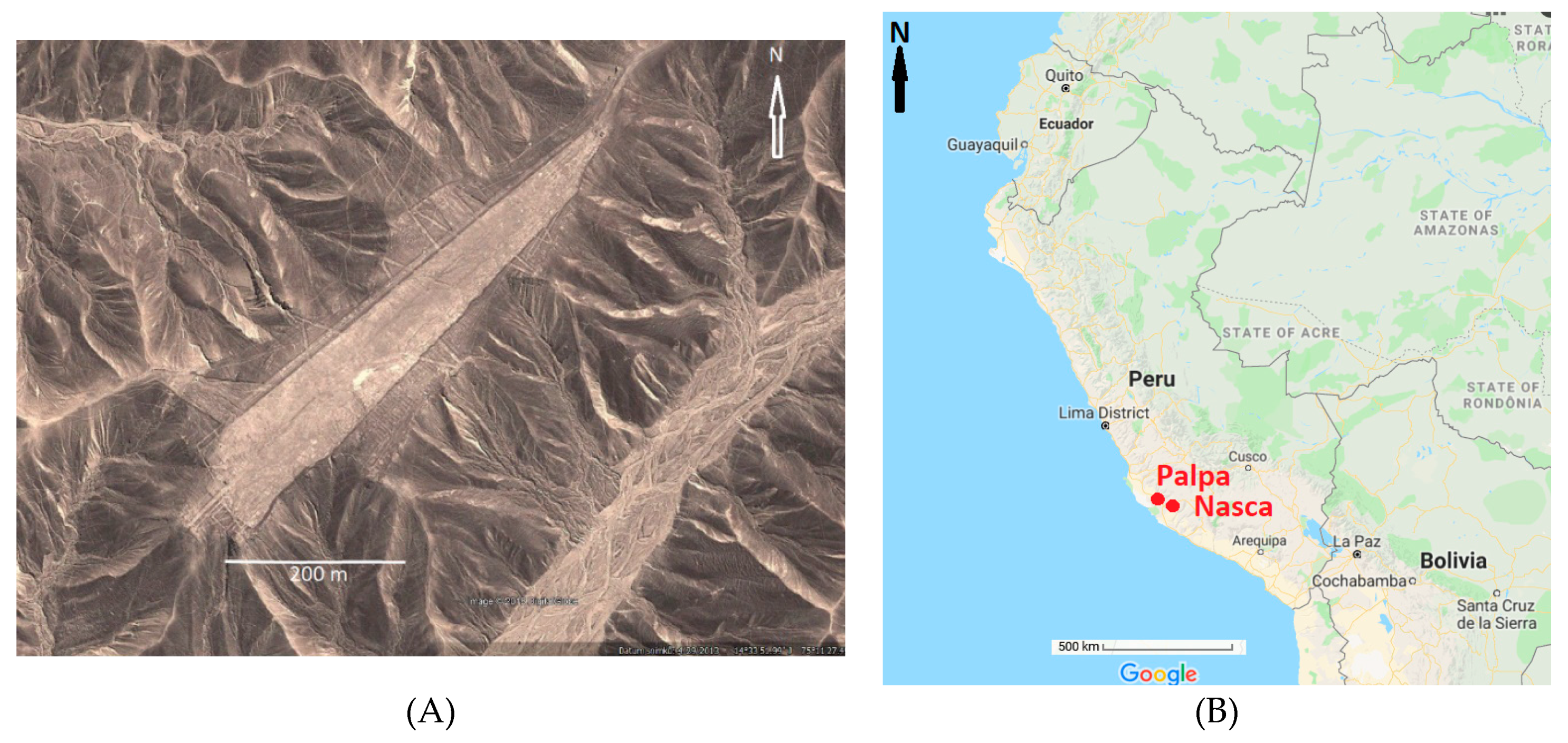
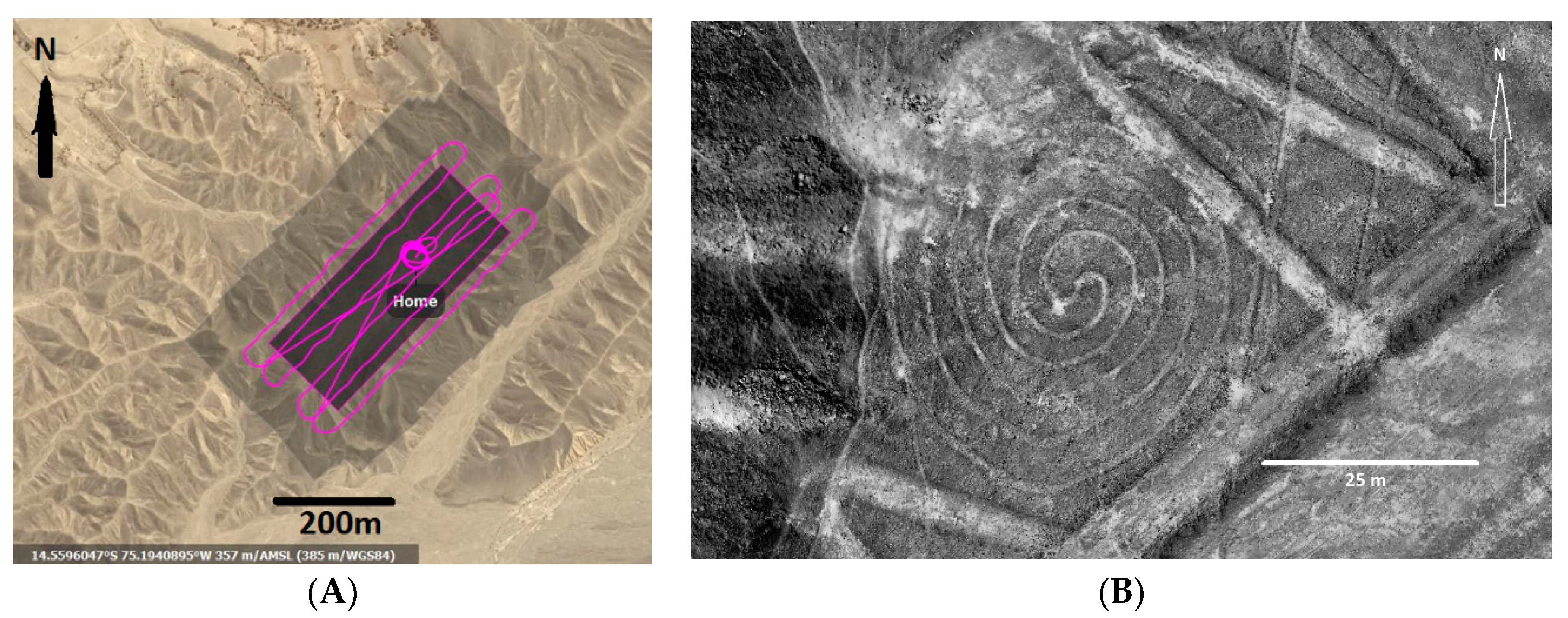
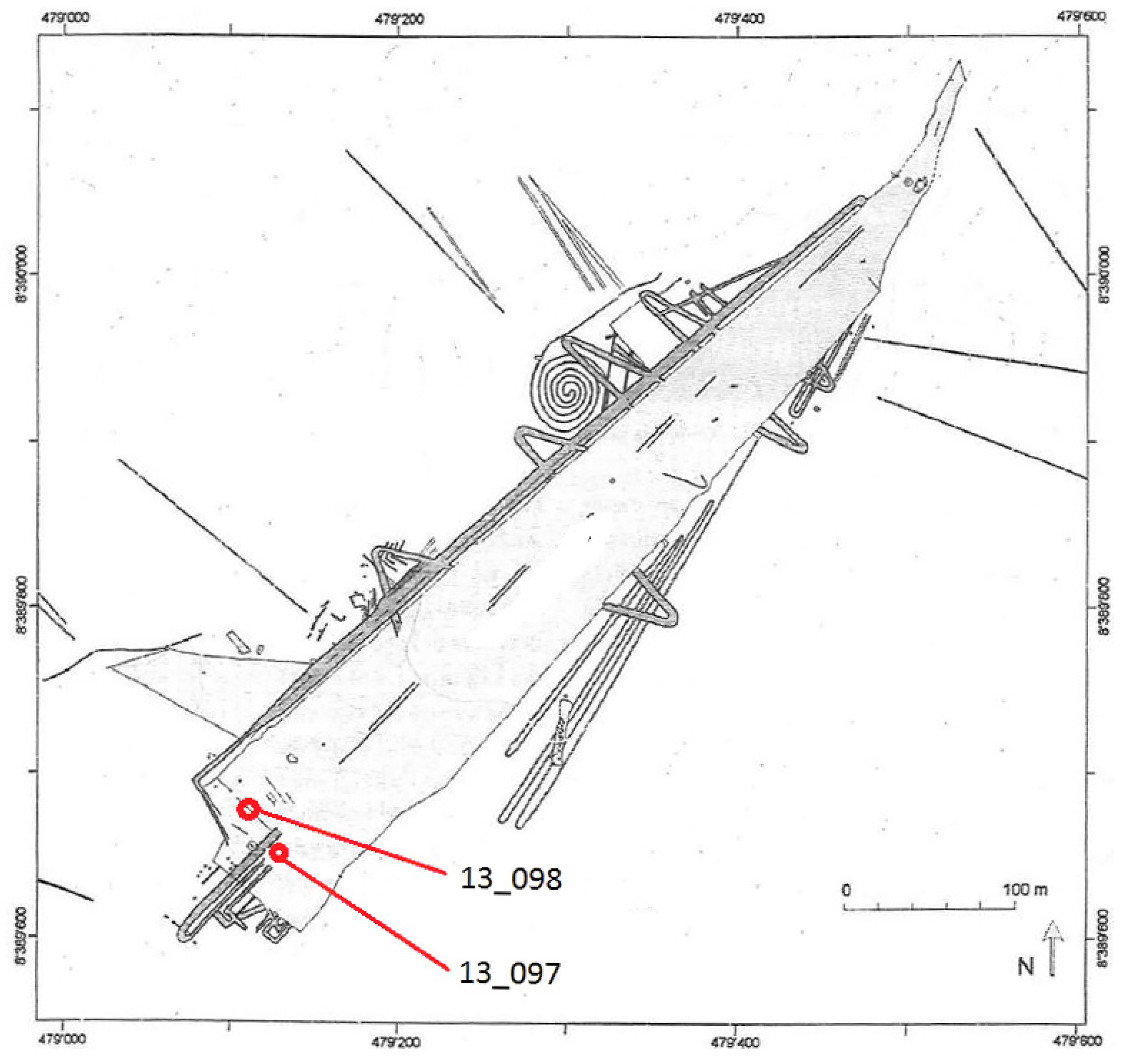
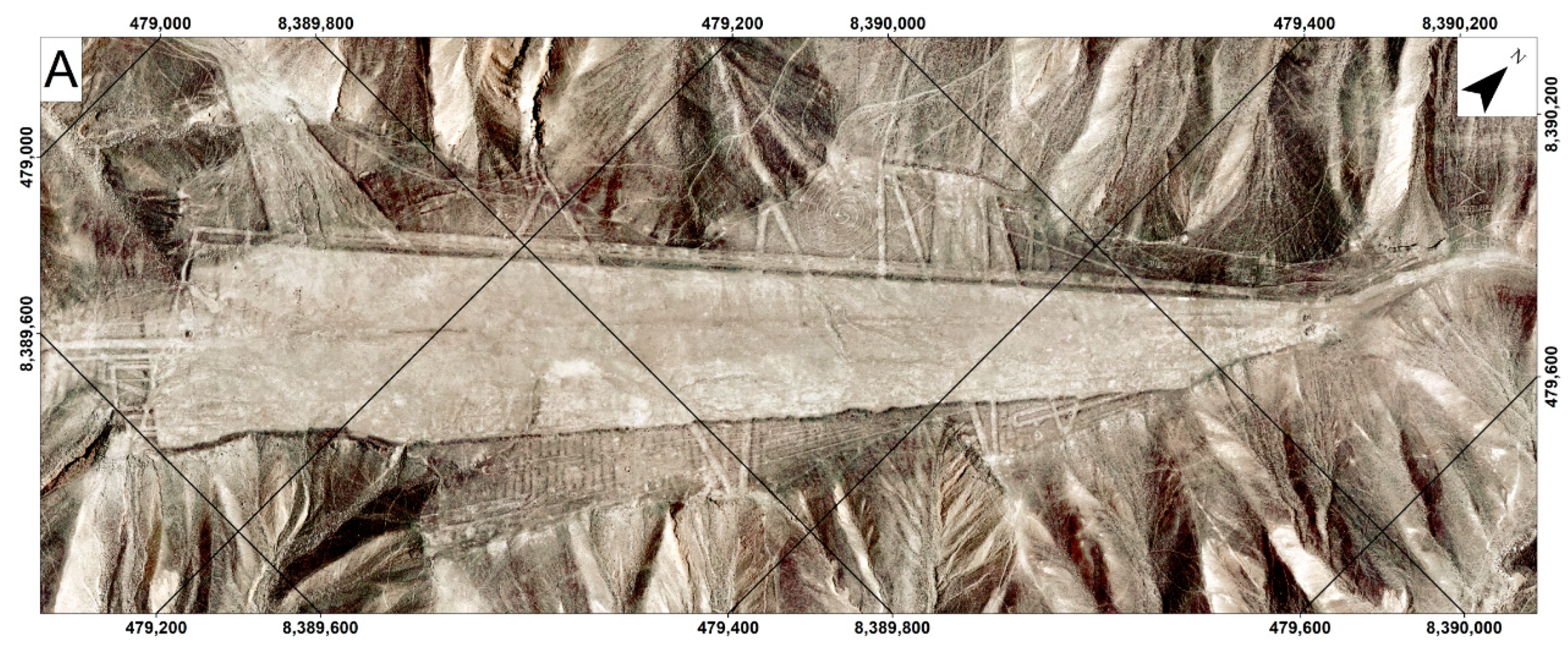
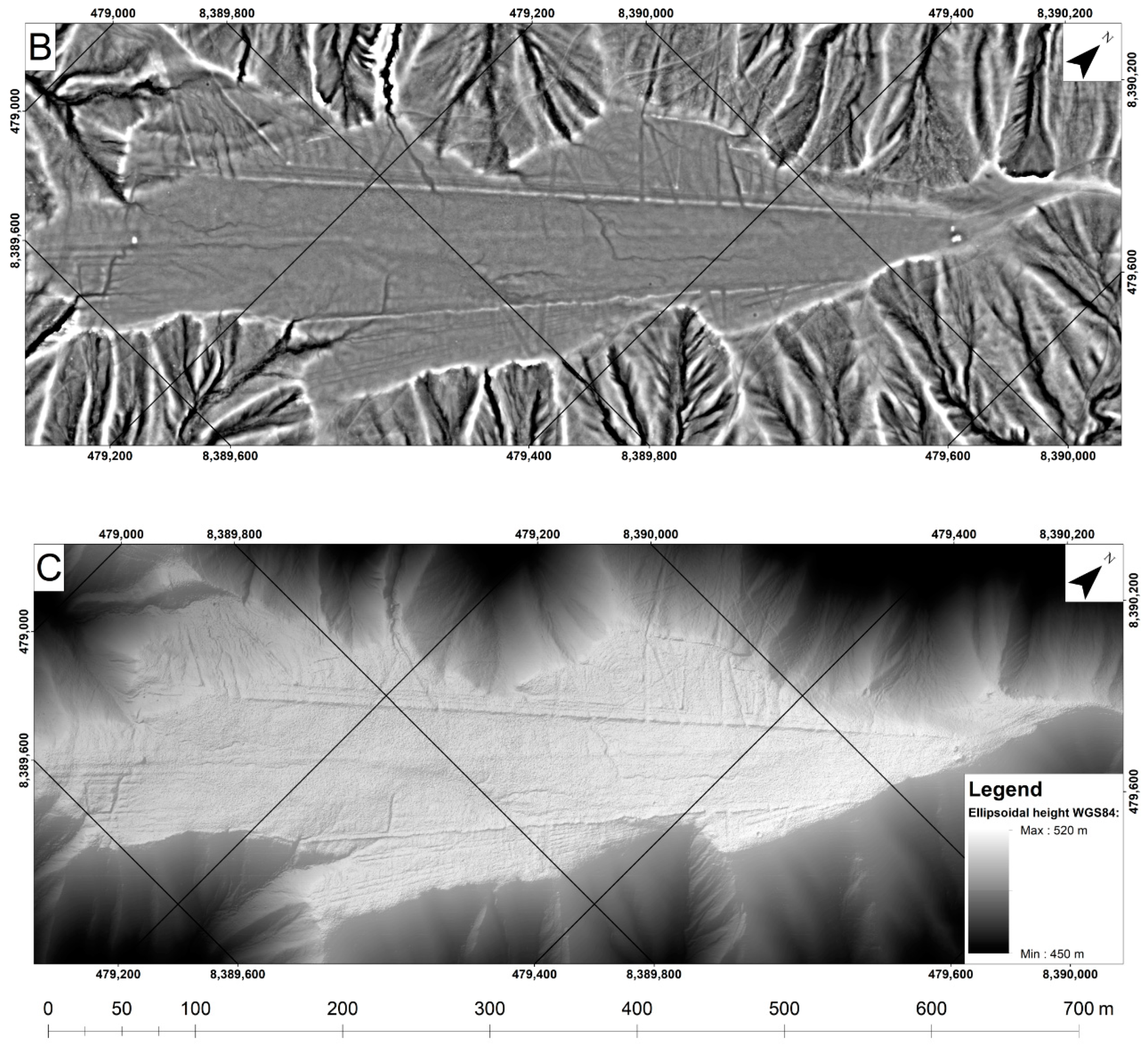
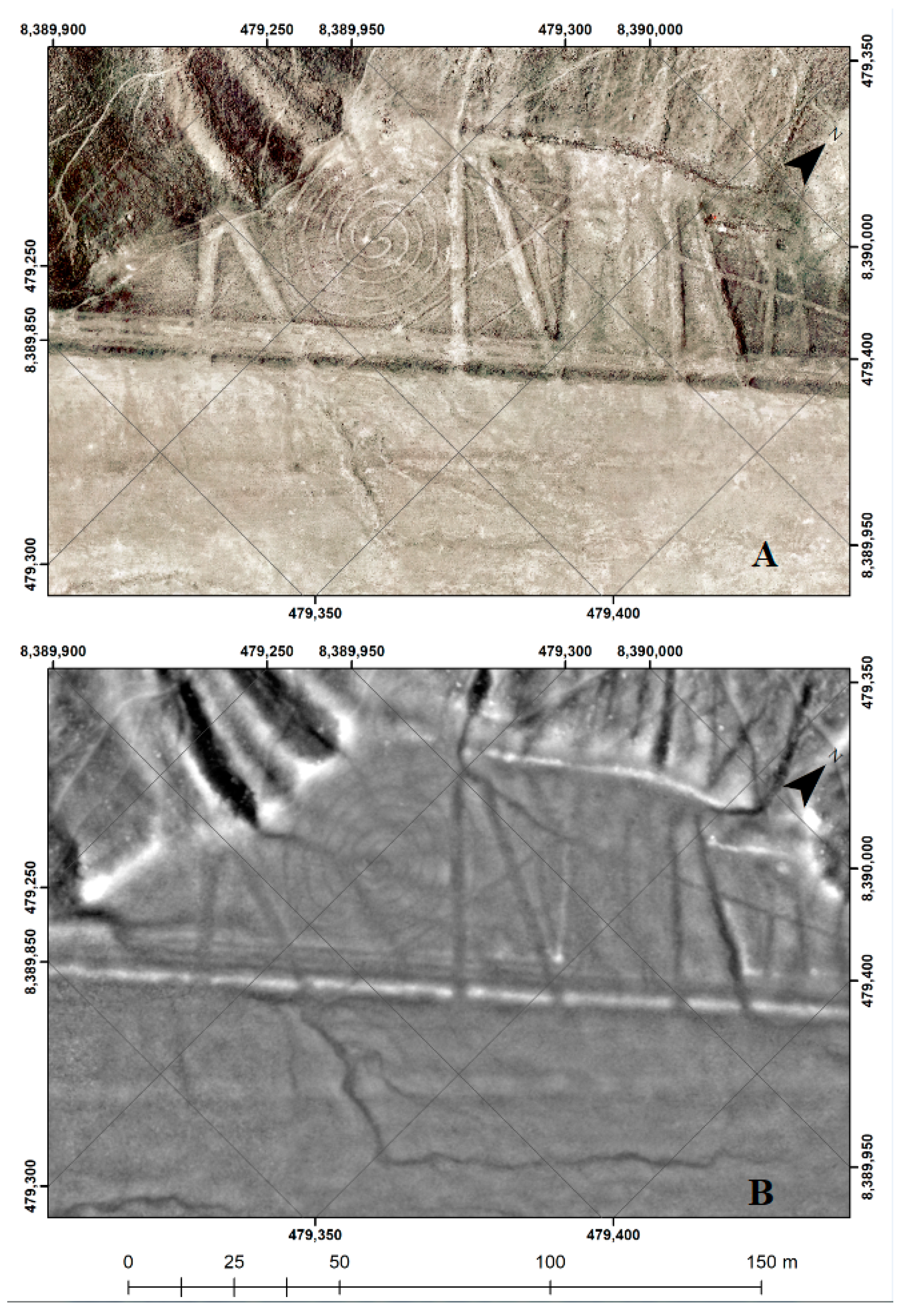
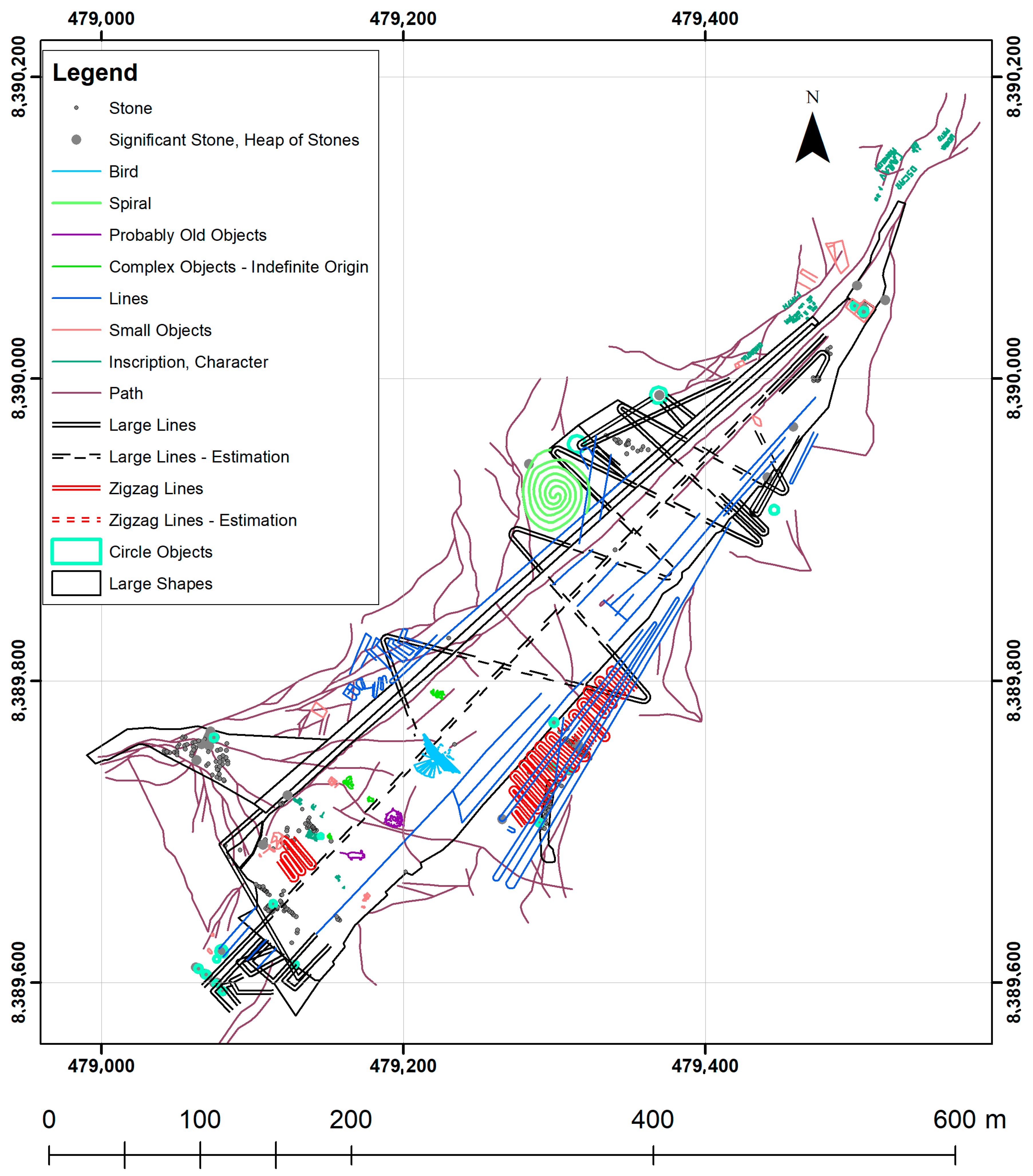
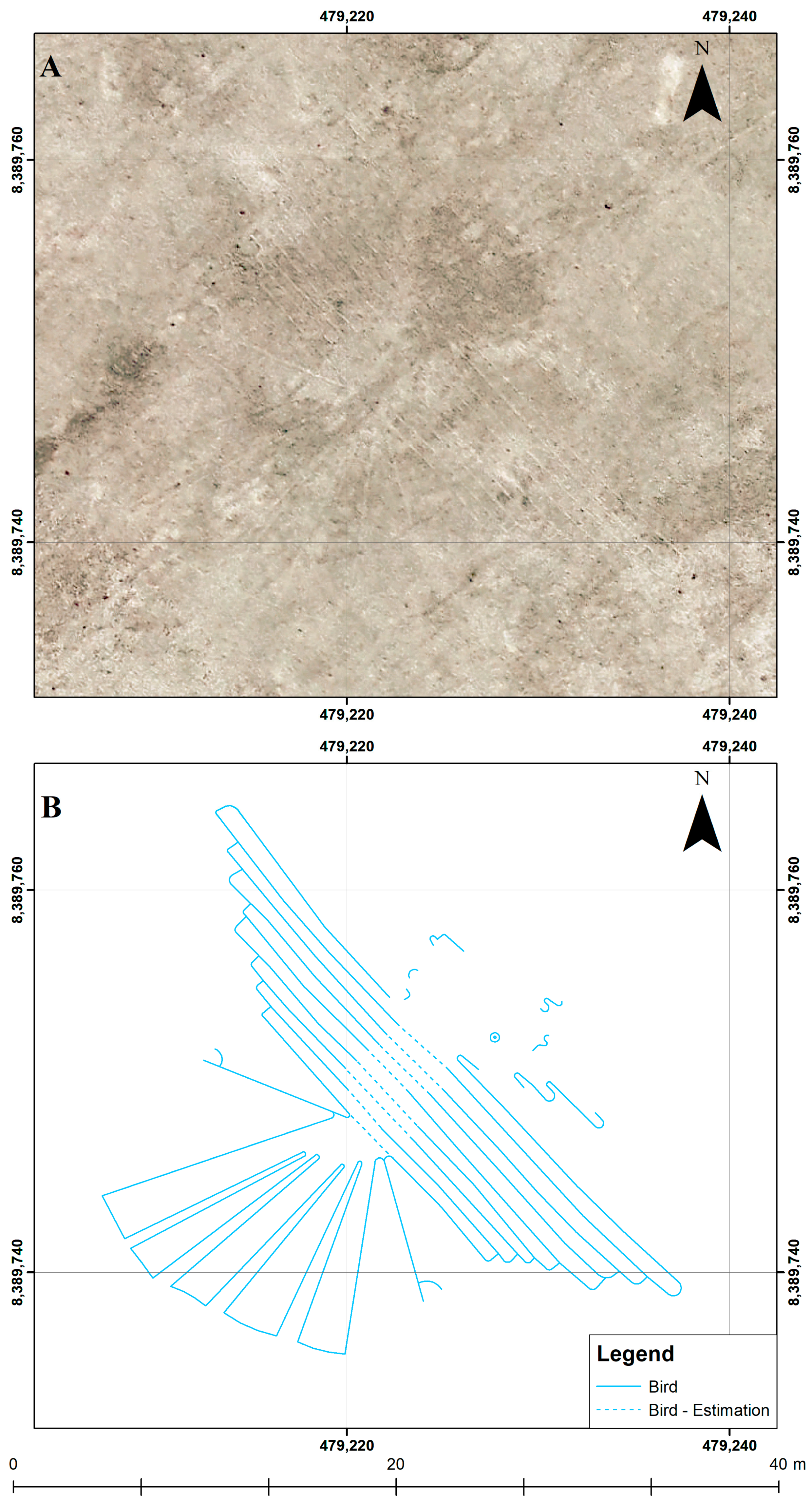
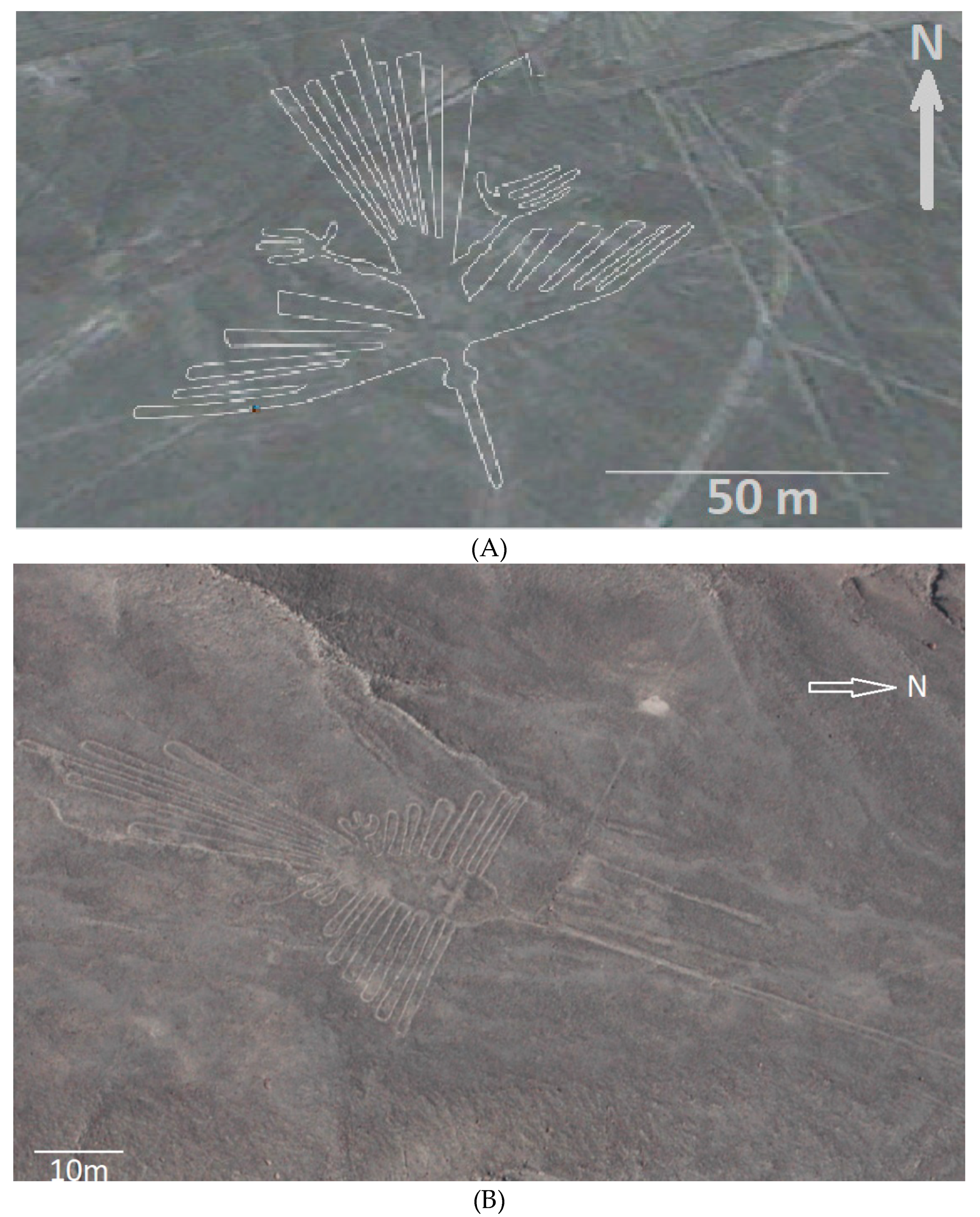
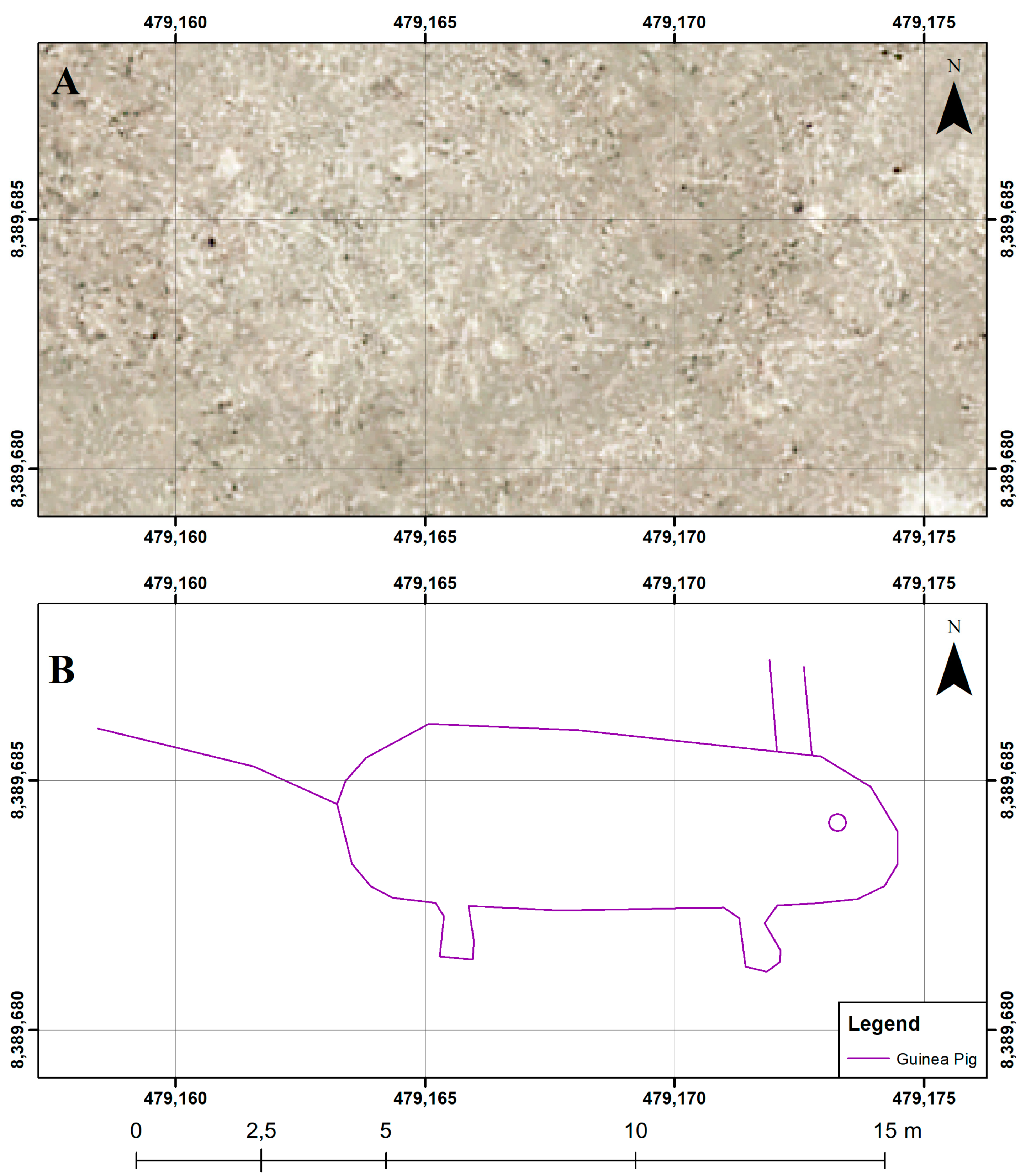
| Sample | Description | Conventional Radiocarbon Age (BP) | Calibrated Age (AD) | P (%) Probability |
|---|---|---|---|---|
| 13_097 | Palpa, 1, geoglyph Pista | 76 ± 88 | 1666–1783 1796–1949 1666–1949 | 39(2σ) 61(2σ) 96(2σ) |
| 13_098 | Palpa, 2, geoglyph Pista | 434 ± 74 | 1440–1511 1572–1622 1415–1643 | 58 (σ) 35(σ) 95(2σ) |
| 13_098 (AMS) | Palpa, 2, geoglyph Pista | 473 ± 32 | 1420–1499 | 92 |
| X [m] | Y [m] | Z [m] | |
|---|---|---|---|
| Mean | −0.003030 | −0.004991 | 0.122334 |
| σ | 0.706982 | 0.444677 | 1.748451 |
| RMS Error | 0.706988 | 0.444705 | 1.752725 |
| Number of 3D points | 12.563.698 |
| Point density (per m2) | 21.06 |
| DSM and orthophoto resolution (GSD) | 5.05 cm/pixel |
| Output coordinate system | WGS84/UTM zone 18S |
© 2018 by the authors. Licensee MDPI, Basel, Switzerland. This article is an open access article distributed under the terms and conditions of the Creative Commons Attribution (CC BY) license (http://creativecommons.org/licenses/by/4.0/).
Share and Cite
Pavelka, K.; Šedina, J.; Matoušková, E. High Resolution Drone Surveying of the Pista Geoglyph in Palpa, Peru. Geosciences 2018, 8, 479. https://doi.org/10.3390/geosciences8120479
Pavelka K, Šedina J, Matoušková E. High Resolution Drone Surveying of the Pista Geoglyph in Palpa, Peru. Geosciences. 2018; 8(12):479. https://doi.org/10.3390/geosciences8120479
Chicago/Turabian StylePavelka, Karel, Jaroslav Šedina, and Eva Matoušková. 2018. "High Resolution Drone Surveying of the Pista Geoglyph in Palpa, Peru" Geosciences 8, no. 12: 479. https://doi.org/10.3390/geosciences8120479
APA StylePavelka, K., Šedina, J., & Matoušková, E. (2018). High Resolution Drone Surveying of the Pista Geoglyph in Palpa, Peru. Geosciences, 8(12), 479. https://doi.org/10.3390/geosciences8120479






